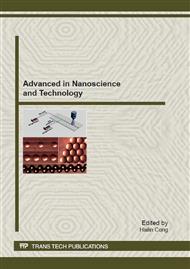[1]
Osamu Tabata, PH-controlled TMAH solutions for silicon micromachining, Sensors and Actuators A. 53(1996)335-339.
DOI: 10.1016/0924-4247(96)80157-9
Google Scholar
[2]
Pandy. A, Landsbekger.L. M, Nikpour. E, Experimental investigation of high Si/A1 selectivity during anisotropic etching in tetramethyl ammonium hydroxide, J. Vac. Sci. Technol. 16(1998): 868-872.
DOI: 10.1116/1.581025
Google Scholar
[3]
Schnakenberg. U, Benecke. W, Lange. P, TMAHW solutions for silicon micro-machining, Tech. Dig. 6th Int. Conf. Solid state sensors and actuutors. (1991) 815-818.
DOI: 10.1109/sensor.1991.149008
Google Scholar
[4]
Sarro.P. M, Brida. S, Vlist. W, Aluminium passivation in saturated TMAHW solutions for IC-compatible microstructues and device isolation, Proc. SPIE-Int. Soc. for optical engineering. 2879(1996)242-25.
DOI: 10.1117/12.251213
Google Scholar
[5]
Erno H Klaassen, Richard J Reay, Christopher Storment, et al, Micromachined thermally isolated circuits, Sensors and Actuators A. 58(1997)43-50.
DOI: 10.1016/s0924-4247(97)80223-3
Google Scholar
[6]
Tea.N. H, Milanovic. V, Zincke.C. A, et al, Hybrid postprocessing etching for CMOS-compatible MEMS, Microelectromechanical Systems, Journal of. 6(1997)363-372.
DOI: 10.1109/84.650134
Google Scholar
[7]
Guizhen Yan, Philip C.H. Chan, I-Ming Hsing, et al, An improved TMAH Si-etching solution without attacking exposed aluminum, Sensors and Actuators A. 89(2001)135–141.
DOI: 10.1016/s0924-4247(00)00546-x
Google Scholar
[8]
Norio Fujitsuka, Kanae Hamaguchi, Hirofumi Funabashi, et al, Silicon anisotropic etching without attacking aluminum with Si and oxidizing agent dissolved in TMAH solution, Sensors and Actuators A. 114(2004)510–515.
DOI: 10.1016/j.sna.2003.11.013
Google Scholar
[9]
K. Biswas, S. Kal, Etch characteristics of KOH, TMAH and dual doped TMAH for bulk micromachining of silicon, Microelectronics Journal. 37(2006)519–525.
DOI: 10.1016/j.mejo.2005.07.012
Google Scholar
[10]
K. Biswas, S. Das, D.K. Maurya, et al, Bulk micromachining of silicon in TMAH-based solutions for aluminum passivation and smooth surface, Microelectronics Journal. 37(2006)321–327.
DOI: 10.1016/j.mejo.2005.05.013
Google Scholar
[11]
Lian. K, Stark. B, Gundlach.A. M, et al, Aluminium passivation for TMAH based anisotropic etching for MEMS applications, Electronics Letters. 35(1999) 1266-1267.
DOI: 10.1049/el:19990744
Google Scholar
[12]
A Tarraf, J Daleiden, S Irmer, et al, Stress investigation of PECVD dielectric layers for advanced optical MEMS, J. Micromech. Microeng. 14 (2004) 317–323.
DOI: 10.1088/0960-1317/14/3/001
Google Scholar
[13]
W. A. P. Claassen, W. G. J. N. Valkenburg, et al, Influence of Deposition Temperature, Gas Pressure, Gas Phase Composition, and RF Frequency on Composition and Mechanical Stress of Plasma Silicon Nitride Layers, J. Electrochem. Soc. 132(1985).
DOI: 10.1149/1.2113980
Google Scholar
[14]
P.R. Scheeper, J.A. Voorthuyzen, P. Bergveld, PECVD silicon nitride diaphragms for condenser microphones, Sensors and Actuators B, 4(1991)79-84.
DOI: 10.1016/0925-4005(91)80180-r
Google Scholar
[15]
F. Jansen, A. Day and L. Wamboldt, On the chemical and mechanical properties of sputtered silicon nitride film, Thin Solid Films. 219(1992)139-145.
DOI: 10.1016/0040-6090(92)90734-s
Google Scholar
[16]
Ong Poh Lam, Wei Jiashen, Tay Francis E. H, et al, A new fabrication method for low stress PECVD–SiNx layers, Journal of Physics: Conference Series. 34(2006)764–769.
DOI: 10.1088/1742-6596/34/1/126
Google Scholar


